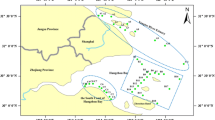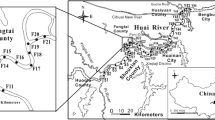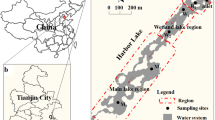Abstract
Due to proximity to the urban and industrial areas, coastal environments of the Osaka Bay have been continuously polluted with the human activities. Coastal sediments are known as large pool of contaminants including heavy metals. The Osaka Bay is no exception. However, recent information regarding the distributions, geochemical speciations, and risk evaluations of metals is limited for coastal sediments in the Bay. Therefore, we investigated the distributions, geochemical speciations, bioavailabilities, and conducted risk evaluations of the heavy metals, such as cadmium (Cd), copper (Cu), lead (Pb), and zinc (Zn) in sediments collected from 25 sites of the urban coastal environment of Osaka Bay, Japan. We observed high concentrations of Zn (76–967 mg/kg dry weight; DW) followed by Cu (not detected; ND-399 mg/kg DW), Pb (ND-73 mg/kg DW), and Cd (0.2–2.9 mg/kg DW). A considerable fraction of Cd was exchangeable (ND-0.4 mg/kg DW) and carbonate-bound (0.03–0.4 mg/kg DW). Cu occurred predominantly in the organic material-bound fraction (ND-348 mg/kg DW). Both Pb and Zn occurred predominantly in the Fe-Mn oxide fraction, with concentration ranges of ND-41 mg/kg DW and 24–277 mg/kg DW, respectively. Comparison with the effect range low (ERL) and effect range median (ERM) revealed that Cd, Cu, and Zn contribute potential biological toxicities to the sediments of Osaka Bay. High bioavailable concentrations of Cd and Zn may have ecotoxicological significance, because these metals are potentially highly available, especially to the benthic organisms.





Similar content being viewed by others
References
Bastami, K. D., Bagheri, H., Kheirabadi, V., Zaferani, G. G., Teymori, M. B., Hamzehpoor, A., Soltani, F., Haghparast, S., Harami, S. R. M., Ghorghani, N. F., & Ganji, S. (2014). Distribution and ecological risk assessment of heavy metals in surface sediments along southeast coast of the Caspian Sea. Marine Pollution Bulletin, 81, 262–267.
Bastami, K. D., Neyestani, M. R., Esmaeilzadeh, M., Haghparast, S., Alavi, C., Fathi, S., Nourbakhsh, S., Shirzadi, E. A., & Parhizgar, R. (2017). Geochemical speciation, bioavailability and source identification of selected metals in surface sediments of the southern Caspian Sea. Marine Pollution Bulletin, 114, 1014–1023.
Beškoski, V. P., Yamamoto, K., Yamamoto, A., Okamura, H., Hayashi, M., Nakano, T., & Inui, H. (2017). Distribution of perfluoroalkyl compounds in Osaka Bay and coastal waters of Western Japan. Chemosphere, 170, 260–265.
Bhuiyan, M. K. A., Qureshi, S., Billah, M. M., Kammella, S. V., Alam, M. R., Ray, S., & Abu Hena, M. K. (2018). Distribution of trace metals in channel sediment: A case study in South Atlantic Coast of Spain. Water, Air and Soil Pollution, 229, 14.
Billah, M. M., Mustafa Kamal, A. H., Idris, M. H., & Ismail, J. (2017). Mangrove macroalgae as biomonitors of heavy metal contamination in a tropical estuary, Malaysia. Water, Air, and Soil Pollution, 228, 347.
Chaharlang, B. H., Bakhtiari, A. R., Mohammadi, J., & Farshchi, P. (2016). Geochemical partitioning and pollution assessment of Ni and V as indicator of oil pollution in surface sediments from Shadegan wildlife refuge, Iran. Marine Pollution Bulletin, 111, 247–259.
Chen, M., & Ma, L. Q. (2001). Comparison of three aqua regia digestion methods for twenty Florida soils. Soil Science Society of America Journal, 65(2), 491–499.
Delshab, H., Farshchi, P., & Keshavarzi, B. (2017). Geochemical distribution, fractionation and contamination assessment of heavy metals in marine sediments of the Asaluyeh port, Persian gulf. Marine Pollution Bulletin, 115, 401–411.
Du Laing, G., Rinklebe, J., Vandecasteele, B., Meers, E., & Tack, F. M. (2009). Trace metal behaviour in estuarine and riverine floodplain soils and sediments: A review. Science of the Total Environment, 407, 3972–3985.
Essien, J. P., Antai, S. P., & Olajire, A. A. (2009). Distribution, seasonal variations and ecotoxicological significance of heavy metals in sediments of cross river estuary mangrove swamp. Water, Air, and Soil Pollution, 197, 91–105.
Guo, W., Huo, S. L., Xi, B. D., Zhang, J. T., & Wu, F. C. (2015). Heavy metal contamination in sediments from typical lakes in the five geographic regions of China: Distribution, bioavailability, and risk. Ecological Engineering, 81, 243–255.
Hamzeh, M., Baghdad, O., Mirna, D., & Halwani, J. (2014). Trace metal mobilization from surficial sediments of the Seine River estuary. Water, Air and Soil Pollution, 225, 1878.
Hosono, T., Su, C. C., Okamura, K., & Taniguchi, M. (2010). Historical record of heavy metal pollution deduced by lead isotope ratios in core sediments from the Osaka Bay, Japan. Journal of Geochemical Exploration, 107, 1–8.
Jafarabadi, A. R., Alireza, R. B., Nunziacarla, S., & Tiziana, C. (2018). First report of geochemical fractionation distribution, bioavailability and risk assessment of potentially toxic inorganic elements in sediments of coral reef islands of the Persian Gulf, Iran. Marine Pollution Bulletin, 137, 185–197.
Jaysankar, D., Fukami, K., Iwasaki, K., & Okamura, K. (2009). Occurrence of heavy metals in the sediments of Uranouchi inlet, Kochi prefecture, Japan. Fisheries Science, 75, 413–423.
Jones, B., & Turki, A. (1997). Distribution and speciation of heavy metals in surficial sediments from the Tees estuary, north-East England. Marine Pollution Bulletin, 34, 768–779.
Ke, X., Shaofeng, G., Hao, H., Haijun, Z., Chunyong, W., & Wei, G. (2017). Ecological risk assessment and source identification for heavy metals in surface sediment from the Liaohe River protected area, China. Chemosphere, 175, 473–481.
Kitano, Y., & Fujiyoshi, R. (1980). Partitioning of cadmium, copper, manganese and iron into mineral and organic fractions in core sediments from the Osaka Bay. Geochemical Journal, 14, 289–301.
Kitano, Y., Sakata, M., & Matsumoto, E. (1981). Partitioning of heavy metals into mineral and organic fractions in a sediment core sample from Osaka Bay. Journal Ocean Society Japan, 37(5), 259–266.
Koyama, J., Kitoh, A., Nakai, M., Kohno, K., Tanaka, H., & Uno, S. (2013). Relative contribution of endocrine-disrupting chemicals to the estrogenic potency of marine sediments of Osaka Bay, Japan. Water, Air and Soil Pollution, 224, 1570.
Lestari, B. F., & Hindarti, D. (2018) Speciation of heavy metals Cu, Ni and Zn by modified BCR sequential extraction procedure in sediments from Banten Bay, Banten Province, Indonesia." In IOP Conference Series: Earth and Environmental Science, vol. 118, no. 1, p. 012059. IOP Publishing, 2018.
Li, X., Zhenguo, S., Wai, O. W. H., & Yok-Sheung, L. (2001). Chemical forms of Pb, Zn and cu in the sediment profiles of the Pearl River estuary. Marine Pollution Bulletin, 42, 215–223.
Lian, Y. W., Xu, J. S., Lin, P., Meguro, S., & Kawachi, S. (1999). Five heavy metals in propagules of ten mangrove species of China. Journal of Wood Science, 45, 343–347.
Liu, J., Yin, P., Chen, B., Gao, F., Song, H., & Li, M. (2016). Distribution and contamination assessment of heavy metals in surface sediments of the Luanhe River estuary, northwest of the Bohai Sea. Marine Pollution Bulletin, 109, 633–639.
Long, E. R., & MacDonald, D. D. (1998). Recommended uses of empirically derived, sediment quality guidelines for marine and estuarine ecosystems. Human Ecological Risk Assessment, 4, 1019–1039.
Long, E. R., Macdonald, D. D., Smith, S. L., & Calder, F. D. (1995). Incidence of adverse biological effects within ranges of chemical concentrations in marine and estuarine sediments. Environment Management, 19, 81–97.
Lopez-Sachez, J. F., Rubio, R., Samitier, C., & Rauret, G. (1996). Trace metal partitioning in marine sediment and sludge deposited off the coast of Barcelona (Spain). Water Research, 30, 153–159.
Mahanta, M. J., & Bhattacharyya, K. G. (2011). Total concentrations, fractionation and mobility of heavy metals in soils of urban area of Guwahati, India. Environmental Monitoring and Assessment, 173, 221–240.
Masoud, M. S., Tarek, O., Said, G., El, Z., & Shreadah, M. A. (2010). Speciation of Fe, Mn and Zn in surficial sediments from the Egyptian Red Sea coasts. Chemical Speciation and Bioavailability, 22, 257–269.
Miki, S., Uno, S., Ito, K., Koyama, J., & Tanaka, H. (2014). Distributions of polycyclic aromatic hydrocarbons and alkylated polycyclic aromatic hydrocarbons in Osaka Bay, Japan. Marine Pollution Bulletin, 85(2), 558–565.
Mohiuddin, K. M., Ogawa, Y., Zakir, H. M., Otomo, K., & Shikazono, N. (2011). Heavy metals contamination in water and sediments of an urban river in a developing country.International. Journal of Environmental Science & Technology, 8(4), 723–736.
Morillo, J., Usero, J., & Gracia, I. (2002). Partitioning of metals in sediments from the Odielriver (Spain). Environment International, 28, 263–227.
Morillo, J., Usero, J., & Gracia, I. (2004). Heavy metal distribution in marine sediments from the southwest coast of Spain. Chemosphere, 55, 431–442.
Nagaoka, C., Yamamoto, Y., Eguchi, S., & Miyazaki, N. (2004). Relationship between distribution of heavy metals and sedimental condition in the sediment of Osaka Bay. Bulletin of the Japanese Society of Scientific Fisheries (Japanese), 70, 159–167.
Naji, A., Ismail, A., & Ismail, A. R. (2010). Chemical speciation and contamination assessment of Zn and cd by sequential extraction in surface sediment of Klang River Malaysia. Microchemical Journal, 95, 285–292.
Neşer, G., Kontas, A., Ünsalan, D., Uluturhan, E., Altay, O., Darılmaz, E., Küçüksezgin, F., Tekoğul, N., & Yercan, F. (2012). Heavy metals contamination levels at the coast of Aliağa (Turkey) ship recycling zone. Marine Pollution Bulletin, 64, 882–887.
Noah, N. M., & Oomori, T. (2001). Evaluation of heavy metal pollution on the coastal marine. Bulletin of Faculty of Science, University Ryukyus, 81, 93–104.
Nurulnadia, M. Y., Koyama, J., Uno, S., Kito, A., Kokushi, E., Bacolod, E. T., Ito, K., & Chuman, Y. (2014). Accumulation of endocrine disrupting chemicals (EDCs) in the polychaeteParaprionospio sp. from the Yodo River mouth, Osaka Bay, Japan. Environment. Monitoring and Assessment, 186, 1453–1463.
Olajire, A. A., Ayodele, E. T., Oyedirdan, G. O., & Oluyemi, E. A. (2003). Levels and speciation of heavy metals in soils of industrial southern Nigeria. Environment, Monitoring and Assessment, 85, 135–155.
Pardo, R., Barrado, E., Lourdes, P., & Vega, M. (1990). Determination and speciation of heavy metals in sediments of the Pisuerga River. Water Research, 24, 373–379.
Perin, G., Craboledda, L., Lucchese, L., & Orio, A. A. (1985). Heavy metal speciation in thesediments of northern Adriatic Sea. Anew approach for environmental toxicity determination. Heavy Metals in the Environment, 2, 454–456.
Qiao, Y., Yang, Y., Gu, J., & Zhao, J. (2013). Distribution and geochemical speciation of heavy metals in sediments from coastal area suffered rapid urbanization, a case study of Shantou Bay, China. Marine Pollution Bulletin, 68, 140–146.
Rahman, M. A., & Ishiga, H. (2012). Trace metal concentrations in tidal flat coastal sediments, Yamaguchi prefecture, Southwest Japan. Environment Monitoring and Assessment, 184, 5755–5771.
Saeedi, M., Li, L. Y., Karbassi, A. R., & Zanjani, A. J. (2013). Sorbed metals fractionation and risk assessment of release in river sediment and particulate matter. Environment Monitoring and Assessment, 185, 1737–1754.
Sharifinia, M., Taherizadeh, M., Namin, J. I., & Kamrani, E. (2018). Ecological risk assessment of trace metals in the surface sediments of the Persian Gulf and Gulf of Oman: Evidence from subtropical estuaries of the Iranian coastal waters. Chemosphere, 191, 485–493.
Sundaray, S. K., Nayak, B. B., Lin, S., & Bhatta, D. (2011). Geochemical speciation and risk assessment of heavy metals in the river estuarine sediments—A cases study: Mahanadi basin, India. Journal of Hazardous Material, 186, 1837–1846.
Sutherland, T. F., Petersen, S. A., Levings, C. D., & Martin, A. J. (2007). Distinguishing between natural and aquaculture-derived sediment concentrations of heavy metals in the Broughton archipelago, British Columbia. Marine Pollution Bulletin, 54, 1451–1460.
Tessier, A., Campbell, P. G., & Bisson, M. (1979). Sequential extraction procedure for the speciation of particulate trace metals. Analytical Chemistry, 51(7), 844–851.
Tokunaga, S., Hoshika, A., & Tatsumoto, H. (1995). Characterization of bottom sediments from Osaka Bay, Japan. Environmental Geology, 25, 263–269.
Tomlinson, D., Wilson, J., Harris, C., & Jeffrey, D. (1980). Problems in the assessment of heavy metal levels in estuaries and the formation of a pollution index. Helgoland Marine Research, 33, 566–575.
Turekian, K. K., & Wedepohl, K. H. (1961). Distribution of the elements in some major units of the earth's crust. Geological Society of America Bulletin, 72, 175–192.
Uno, S., Tanaka, H., Kokushi, E., Bacolod, E. T., & Koyama, J. (2017a). Distributions of nitrated polycyclic aromatic hydrocarbons in the sediment of Osaka Bay, Japan. Marine Pollution Bulletin, 124(2), 1014-1019.
Uno, S., Kokushi, E., Kawano, M., McElroy, A. E., & Koyama, J. (2017b). Toxic evaluations of sediments in Tokyo Bay, Japan, using Japanese medaka embryos. Environment Science and Pollution Research, 24, 27702–27709.
Vicente-Martorell, J. J., Galindo-Riaño, M. D., García-Vargas, M., & Granado-Castro, M. D. (2009). Bioavailability of heavy metals monitoring water, sediments and fish species from a polluted estuary. Journal of Hazardous Material, 162, 823–836.
Wang, H., Wang, J., Liu, R., Yu, W., & Shen, Z. (2015). Spatial variation, environmental risk and biological hazard assessment of heavy metals in surface sediments of the Yangtze River estuary. Marine Pollution Bulletin, 93, 250–258.
Yang, L., Wang, L., Wang, Y., & Zhang, W. (2015). Geochemical speciation and pollution assessment of heavy metals in surface sediments from Nansi Lake, China. Environment Monitoring and Assessment, 187, 1–9.
Yang, W., Li, X., Pei, J., Sun, T., Shao, D., Bai, J., & Li, Y. (2017). Bioavailability of trace metals in sediments of a recovering freshwater coastal wetland in China's Yellow River Delta, and risk assessment for the macrobenthic community. Chemosphere, 189, 661–671.
Zhang, C., Yu, Z. G., Zeng, G. M., Jiang, M., Yang, Z. Z., Cui, F., Zhu, M. Y., Shen, L. Q., & Hu, L. (2014). Effects of sediment geochemical properties on heavy metal bioavailability. Environment International, 73, 270–281.
Acknowledgements
First author gratefully acknowledges a scholarship from the MEXT (Ministry of Education, Culture, Sports, Science and Technology; Japan). We also thank the Faculty of Fisheries, Kagoshima University for providing necessary facilities for this research work.
Funding
This work was supported by JSPS KAKENHI grant number JP18K11667.
Author information
Authors and Affiliations
Corresponding author
Additional information
Publisher’s Note
Springer Nature remains neutral with regard to jurisdictional claims in published maps and institutional affiliations.
Rights and permissions
About this article
Cite this article
Billah, M.M., Kokushi, E. & Uno, S. Distribution, Geochemical Speciation, and Bioavailable Potencies of Cadmium, Copper, Lead, and Zinc in Sediments from Urban Coastal Environment in Osaka Bay, Japan. Water Air Soil Pollut 230, 157 (2019). https://doi.org/10.1007/s11270-019-4196-8
Received:
Accepted:
Published:
DOI: https://doi.org/10.1007/s11270-019-4196-8




